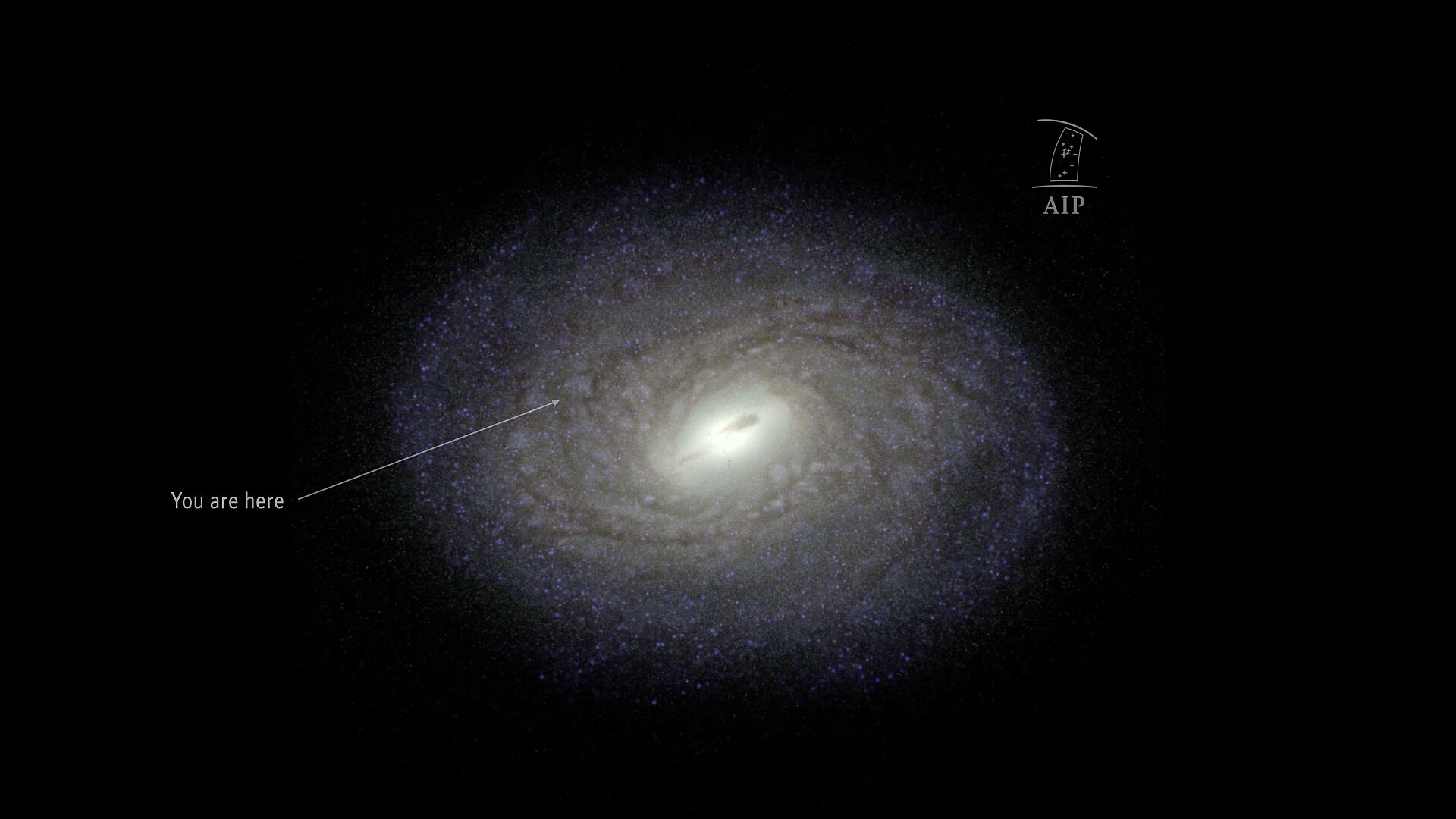Mapping the Milky Way: The difficult view from within
Mapping the Milky Way: The difficult view from within
28.05.2025
From May to August 2025, Sergey Khoperskov from the Leibniz Institute for Astrophysics Potsdam is Ida Pfeiffer Professor at our Faculty. In his work he focusses on galaxy formation and evolution, and especially on the Milky Way as a "typical galaxy population in the universe", where he also developed a special techniques to map it's chemo-kinematic structure. Sergey Khoperskov is constantly shifting from the "microphysics" of star formation to the macrophysics of the formation of galaxies and their groups. This "challenges me to contiuously shift perpective, zooming in and out to approach problems from multiple angles", he explains in this "Currently visiting" interview.

Sergey Khoperskov from the Leibniz Institute for Astrophysics Potsdam is visiting our Faculty as Ida Pfeiffer Professor in the summer term 2025. Photo: Sergey Khoperskov
- In your research you are concentrating on our own Galaxy, the Milky Way. What makes the Milky Way such a fascinating subject of study?

Milky Way - Your are here. Copyright: S. Khoperskov (AIP)
Sergey Khoperskov: My research lies at the intersection of Galactic archaeology, Galactic dynamics, and near-field cosmology. These three broad fields converge within our own Galaxy — the Milky Way, and its immediate surroundings, including Andromeda and its system of satellite galaxies, collectively forming the Local Group.
What makes this region especially compelling is not merely its proximity, but the fact that galaxies of this mass and structure are representative of the typical galaxy population in the universe. By studying their present-day properties and reconstructing their evolutionary histories, we gain deep insight into how galaxies, in general, form and evolve over cosmic time.
- From the galactic past to near-field cosmology, from theoretical astrophysics to computation astrophysics and oberservations: This seems like a very broad research range. Where would you position yourself within this field?
Sergey Khoperskov: I am primarily a theoretical astrophysicist, and my work involves using supercomputing simulations to model the formation and long-term evolution of galaxies. In parallel, I apply data-driven techniques to extract scientific insight from large stellar surveys, integrating theory with observations. Moreover, the tools of stellar and galactic dynamics offer a powerful framework for bridging scales: linking the “microphysics” of star formation, the interstellar medium, and stellar evolution with the physics of galaxies and their groups.
This constant interplay, from the internal lives of stars to the architecture of galaxies, challenges me to continuously shift perspective, zooming in and out to approach problems from multiple angles. I find this multiscale approach to be one of the most intellectually stimulating and rewarding aspects of my work.
Post-processed radiative transfer visualization of the Milky Way hydrodynamic simulation constrained by spectroscopic observations and augmented using stellar orbit superposition. Copyright: S. Khoperskov (AIP)
Zoom-in simulations for the Local Group - HESTIA-2; detailed information can be found at the Hestia-2 page on Sergey Khoperskov's homepage. Copyright: S. Khoperskov (AIP)
- Let's dive a little bit deeper into your different research strands: Which three publications characterise your work?
Sergey Khoperskov: That’s an interesting question — it prompted me to reflect on past work I don’t often revisit. One project that stands out is my study on the quenching of star formation in barred galaxies, conducted during my time at the Paris Observatory. While the idea originated with my supervisors, I developed and tested the hypothesis, which offered a practical explanation for the observed lack of young stars in barred systems, including the Milky Way. It was a rewarding experience that taught me the value of being open to guidance — sometimes, following a mentor’s lead can lead to impactful results.
S. Khoperskov, M. Haywood, P. Di Matteo, M. D. Lehnert, & F. Combes. Bar quenching in gas-rich galaxies. A&A 609, A60 (2018).
Identifying the Galaxy's spiral arms
Another project I would highlight is my work on mapping the spiral structure of the Milky Way — my first in-depth experience working with real data, specifically the landmark Gaia Data Release 2 from the European Space Agency. This was a technically and intellectually rewarding challenge, as I set out to identify the Galaxy’s spiral arms. One of the key difficulties in studying the Milky Way is our internal perspective: we cannot observe it from the outside. Even Gaia’s remarkable dataset remains incomplete and affected by a complex selection function. Additionally, the stellar motions themselves — combining circular orbits with vertical oscillations — obscure the spatial coherence of spiral features. I spent several months tackling these issues and eventually developed a method to transform stellar positions into a pseudo-kinematic space, where the spiral arms become distinctly visible. This project demanded sustained focus and creativity — qualities I strive to bring to every aspect of my research.
Copyright: S. Khoperskov (AIP)
S. Khoperskov, O. Gerhard, P. Di Matteo, M. Haywood, D. Katz, et al. Hic sunt dracones: Cartography of the Milky Way spiral arms and bar resonances with Gaia Data Release 2. A&A 634, L8 (2020).
Unintentional discovery
Last but not least, I would mention my work on understanding vertical oscillations in the Milky Way disc, visible today as the now well-known phase-space spiral — often referred to as the snail — revealed by the Gaia mission. Interestingly, this project began somewhat unintentionally.
S. Khoperskov, P. Di Matteo, O. Gerhard, D. Katz, M. Haywood, et al. The echo of the bar buckling: Phase-space spirals in Gaia Data Release 2. A&A 622, L6 (2019).
A few months before the Gaia Data Release, we had surplus computing time and no immediate simulation plans. Almost out of curiosity, I decided to re-run one of our best Milky Way models at 20 times higher resolution, reaching approximately 160 million star particles — to my knowledge, one of the highest-resolution simulations of its kind at the time.
The simulation did not begin with a specific scientific goal; I was simply interested in observing how such high resolution might influence the dynamical evolution of the stellar component. Yet when Gaia later revealed the phase-space spiral, this dataset proved unexpectedly valuable. Our simulation, due to its fine resolution and carefully constructed model, revealed a previously unrecognized mechanism: vertical wave excitation across the disc, triggered by the formation of the central bulge. Remarkably, the simulated features closely matched those seen in the Gaia data.
- You will teach a course on Computational Galactic Dynamics to our students during your Ida Pfeiffer Professorship. Which central message should your students remember?
Sergey Khoperskov: Building on my previous reflections, I encourage students to value both guidance and independence: listen to the advice of mentors, but also pursue their own ideas with confidence. While careful planning is essential in scientific research, it is equally important to remain open to curiosity-driven exploration. Some of the most meaningful discoveries arise not from rigid plans, but from the willingness to explore — and, occasionally, from a bit of well-timed unexpected opportunity and luck.

Copyright: Sergey Khoperskov
- Why did you decide to apply as Ida Pfeiffer Professor and join our Faculty for this summer term?
Sergey Khoperskov: I was drawn to your Faculty because of its strong international reputation in Galactic and extragalactic astrophysics, as well as its commitment to interdisciplinary collaboration across astronomy, cosmology, and planetary sciences. The presence of both observational and theoretical research groups provides a stimulating environment for advancing my own work, while also contributing meaningfully to the scientific community here.
Academic rigor and curiosity-driven learning
Equally important to me is the opportunity to teach and mentor students in an institution that values both academic rigor and curiosity-driven learning. I find your Faculty’s emphasis on integrating research with teaching especially compelling, as it aligns closely with my own belief that students benefit most when they are exposed to active, ongoing scientific inquiry.
Thank you & welcome to our Faculty!
Ida Pfeiffer Professorship @ FGGA
The Ida Pfeiffer Professorship of the Faculty of Earth Sciences, Geography and Astronomy supports our mission to conduct excellent research on the sustainability of Planet Earth. Since 2018, the Faculty has been inviting scientists for one semester to trigger exciting research as well as teaching and act as a catalyst in the wide range of research topics addressed at the Faculty. Image: Ida Pfeiffer, Lithography by Adolf Dauthage
About the Person

(C) Sergey Khoperskov
Sergey Khoperskov is a postdoctoral research associate at the Leibniz Institute for Astrophysics Potsdam (Germany), specializing in computational astrophysics, galactic dynamics, and near-field cosmology. His work focuses on unraveling the mechanisms driving galaxy formation and evolution, with a particular emphasis on reconstructing the Milky Way’s structure and history through high-resolution simulations and analysis of large-scale stellar surveys such as Gaia, APOGEE, GALAH, and LAMOST. Dr. Khoperskov has developed innovative methods to interpret complex galactic phenomena, including the application of orbit superposition techniques to map the Milky Way's chemo-kinematic structure. His research also encompasses the dynamics of galactic discs, the formation of spiral structures, and the influence of the Local Group environment on galaxy evolution.
- Homepage
- Working group / host professor at our Faculty: Glenn van de Ven / Group Dynamics of Stellar Systems, Department of Astrophysics
- Course in the summer term 2025: 280549 SE Computational Galactic Dynamics

